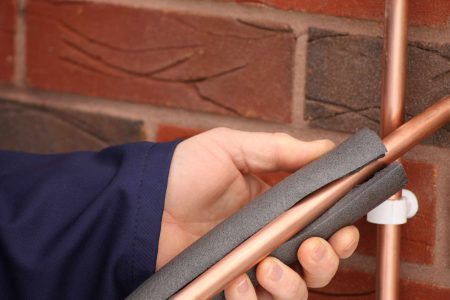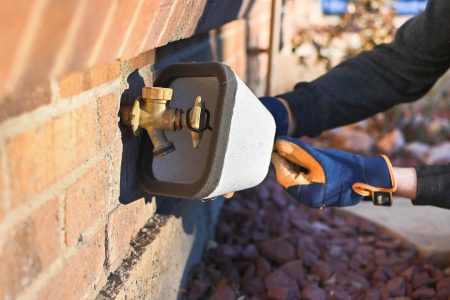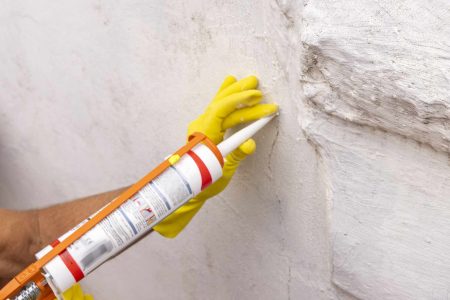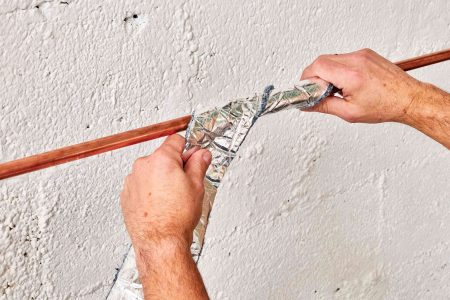Building a wood retaining wall reshapes slopes on your property to control erosion and create level areas for driveways, gardens, paver patios, and decks. Although uncomplicated and relatively inexpensive, building a retaining wall using timber instead of concrete blocks can still be labor-intensive.
The best types of wood for a wood retaining wall are pressure-treated pine and fir, which are rated for ground contact. Read on for step-by-step instructions to build a wood retaining wall.
What Is a Retaining Wall?
A retaining wall holds back the soil behind it and is used for erosion control and terracing.
What to Consider Before Building a Wood Retaining Wall
- Retaining wall height: Build the wood retaining wall 30 inches or lower. Higher retaining walls may collapse due to hydrostatic pressure behind the wall.
- Anchoring the wall: Anchor the retaining wall with four-by-four posts. Similar to a wood fence, dig post holes for the posts. Nail pressure-treated boards across the backs of the posts on the slope side.
- Preparing the work area: Remove rocks, refuse, and plants to prepare the work area. Uproot plants in the way of the retaining wall. Rake the area smooth and level.
- Permits and regulations: Check with your local permitting office for information about permits and retaining wall heights.
- Cost: A pro will install a wood retaining wall for $15 to $30 per square foot. For a 16-foot wood retaining wall will cost from $480 to $960. Installing a wood retaining wall by yourself costs about half of that; or, around $250 to $500.
When to Build a Solid Wood Retaining Wall
The best time to build a retaining wall is when the ground is dry. In most regions, late spring or early summer work well. If you live in a frost-free region, you can build the wall during winter if the soil is dry.
Location for a Retaining Wall
The best spot for the wall is the one that needs it the most. In spots where the soil is eroding, the top soil becomes thinner. Signs of soil erosion include exposed roots, spots of no plant growth, or compacted, hard soil spots.
What You’ll Need
Equipment / Tools
- Post hole auger or manual post hole digger
- Hammer
- Shovel
- Power miter saw or circular saw
- Bubble level
- Laser level
- Measuring tape
Materials
- 2 2 x 6 pressure-treated lumber boards, each 8 feet long
- 6 2 x 8 pressure-treated lumber boards, each 8 feet long
- 8 bags of 50-pound fast-setting concrete mix
- 8 0.8-cubic-foot bags of 7/8-inch drainage rock
- 2 wood stakes
- Scrap 2 x 4s
- Ordinary twine or yellow braided nylon mason line
- Box of 16d hot-dipped galvanized nails
- Wood preservative
Instructions
How to Build a Wood Retaining Wall
-
Mark the Location With Stakes
Stake the area where you plan to build the wall. Pound a stake at one end, then drive another stake 186-1/2 inches away if you plan to extend the wall longer than 16 feet. Run the line from one stake to the next and pull it taut.
-
Cut Into the Slope
Dig laterally about 2 feet back into the slope. Dig far enough to give yourself enough room to work on the retaining wall.
-
Dig a Trench Along the Line
Dig a trench about 5 inches deep where the retaining wall will rest. Lay down one of the boards with the bubble level on top to ensure level. The flat-bladed shovel provides the ideal width for digging out the trench.
-
Mark Other Post Locations
Pound six more stakes between the two end stakes. The stakes should be equally spaced apart. Each stake represents the center position of a post hole. The ideal post spacing for wood retaining walls is roughly 2 feet apart. Each stake represents the center position of a post hole.
-
Dig Post Holes
Dig down 28 inches (24 inches for the post, plus 4 inches for the post’s gravel bed). Make each post hole 12 inches in diameter.
-
Add Gravel to Post Holes
Pour 4 inches of gravel into the bottom of each post hole. You should be able to spread one bag of gravel for every two holes (or four bags of gravel between the eight holes).
-
Set Posts in Holes
Cut each of the 2-by-6 posts in half so that you have eight posts, each post 4 feet long. Daub the cut ends of the lumber with wood preservative. Place the posts in each hole. Plumb each post with the laser level. Use scrap lumber for stakes to hold it in place.
-
Pour Concrete
Pour one bag of dry quick-set concrete into the hole, followed by the recommended amount of water per the product instructions. Leave the scrap lumber stakes in place until the concrete is set before moving on to the next post.
-
Add Gravel Under Wall Location
Add 2 inches of gravel to the trench where the wall will rest. The gravel will help water drain away and prevent premature rotting of the wood. Otherwise, water will rapidly wick upward through the wood and damage the entire retaining wall.
-
Install Retaining Wall Boards
Install three rows of 2-by-8 boards horizontally behind the posts, starting at the top and working down. The top row of boards should be flush with the tops of the posts. Nail the 2-by-8s to each post with two 16d nails. Install a final row of boards along the bottom, using 2-by-6 boards. The bottom edge of this row will be about 2 inches below ground level.
Warning
Install the boards on the slope side of the posts, not on the downhill side.
-
Backfill Slope Side of Wall
Pour the remaining bags of landscape gravel along the bottom of the retaining wall on the slope side, distributing it evenly. The gravel promotes drainage along the bottom of the wall. Backfill the rest of the cavity with soil.
Tips for Building a Solid Wood Retaining Wall
- Use pressure-treated wood: The average life of a wood retaining wall is about 10 years, although high-quality wood and double-treating it can help you keep your wall in good shape for about 20 years.
- Boards on the slope side: Install the facing board on the slope or backside. This way, the boards press against the posts as they receive pressure from the slope.
- Depth of post holes: With wood retaining walls, the rule of thumb is that the height of the soil you hold back should roughly equal the depth of the post holes.
- Add preservatives: While the faces and factory-cut ends of pressure-treated wood are protected, the ends of site-cut wood are not protected. A copper-based wood preservative is commonly used on cut ends of pressure-treated lumber.
- Control erosion: Keep soil secure behind the retaining wall with plants or grass.
When to Call a Professional
Hire a professional to build a wood retaining wall taller than 30 inches. The project becomes more complex the taller it gets since adding height increases the pressure exerted on the wall.
-
What is the cheapest type of retaining wall?
The cheapest type of retaining wall is made with pressure-treated wood, mainly because it is a DIY-friendly type of wall. Poured concrete is a cheap material, too. But it must be installed by professionals, which raises the overall cost.
-
Do wood retaining walls need drainage?
For drainage, it’s vital to backfill with gravel and not with soil or even a combination of soil and gravel. If soil is used as a backfill, it will become water-logged and excessively heavy, potentially collapsing the retaining wall.
-
What can you do instead of a retaining wall?
Gabion walls are wire cages filled with rocks, and they are a good alternative to a retaining wall. Another alternative is creosote-treated railroad ties, which you can usually source at big box home improvement retailers or lumber yards. Railroad tie lumber is usually a less expensive option.
-
What type of retaining wall lasts the longest?
Pre-cast concrete blocks or poured concrete retaining walls last the longest.
Read the full article here









